
An SEO knowledge base does everything a typical knowledge base does and more. It supports customers, ranks in Google, brings new traffic to your site, and builds your E-E-A-T.
It’s tempting to de-index knowledge bases because they interfere with SEO, complicating keyword maps, impacting rankings, and causing cannibalization. But, done right, they’re a powerful SEO asset.
I make knowledge bases part of my SEO strategy. With an indexed SEO knowledge base, I get even more data in Google Search Console and G4, showing what people are searching for and the problems they’re trying to solve. These insights help me support my audiences better, identify new content opportunities, and prioritize what to write next. I share this data across marketing, sales, and customer service, too.
In this article, I’m sharing everything I know about SEO knowledge bases, from what they are to how to gather and utilize data, and tips for incorporating an SEO knowledge base into your website.
In this article:
Why is SEO important for knowledge bases?
SEO increases views and traffic to your knowledge base.
If your knowledge base isn’t indexed, you’re losing out on traffic.
An optimized knowledge base will rank in Google and receive clicks from keywords your target audience is searching for.
While your knowledge base naturally covers topics specific to your product, it can also rank for broader subjects, capturing potential buyers during the awareness or consideration stages of the marketing funnel.
Beyond serving customers, your SEO knowledge base can also:
- Support prospective buyers.
- Introduce new audiences to your brand.
- Funnel them to your money-generating pages.
Here’s an example from HubSpot’s knowledge base.
The page ranks for “link redirect,” a keyword with 1,000 monthly searches, according to Semrush. A significant bonus, considering the knowledge base is primarily designed to assist HubSpot’s users.
I’ve annotated the screenshot above so you can see two opportunities to support buyers and potentially upsell to them.
- HubSpot includes subscriptions on their knowledge base pages, showcasing where the feature (redirects, in this example) is available. If an existing HubSpot user cannot do what they need to, they might consider upgrading. Or, perhaps someone using different software is experiencing the redirect problem, and can now see that HubSpot is a potential solution.
- HubSpot’s knowledge base includes get-started guides to push existing customers to self-serve, alleviating calls for customer support.
SEO knowledge bases bring data.
If your knowledge base is indexed, then it’s an opportunity to strengthen your SEO and build a trove of data in Google Search Console.
Here’s a peek at one of my client’s Google Search Console graphs for an SEO knowledge base.

The knowledge graph has received 3,370 clicks, and I can dig into specific queries to see what people are looking for when they find our knowledge base. In the next section, I share a step-by-step guide on how to find questions and inspiration for additional topics.
Rank for specific, long-tail keywords.
Many keywords ranking on a knowledge base will be specific, long-tail keyword opportunities.
Because these queries are so specific, they often come with lower competition, making it easier to rank.
By indexing your knowledge base articles, you can capture traffic from hundreds (or even thousands) of these long-tail searches, bringing in users who are highly motivated and already problem-aware, often just one or two clicks away from becoming customers.
Discover common challenges.
When your knowledge base is indexed and generating traffic, it provides a direct insight into the real questions and frustrations your users face.
These insights can:
- Highlight areas where your UX might need improvement.
- Help you improve your product overall.
- Surface confusing features.
- Inform marketing campaign or messaging that helps users.
Instead of guessing your audience’s struggles, you get real data.
Next, let’s look at how you can discover this data.
How to Create an SEO-Friendly Knowledge Base
Creating an SEO–friendly knowledge base is primarily achieved through the preparation and planning of the knowledge base. Here are some key steps.
1. Plan the structure.
The structure of the SEO knowledge base will depend mainly on your wider content strategy, so it’s difficult to say exactly how you should plan the structure. However, there are a few things that I’d almost recommend.
- Use a subfolder, such as /knowledge-base/, to easily manage tracking and research. I’ve provided a step-by-step guide on how to identify knowledge base topics using Google Search Console below. It highlights why this step is so important.
- Think about categories and subcategories similarly to how you’d manage a blog. Your categories and subcategories will help Google understand how topics are related and can also help with internal linking; relevant knowledge base articles should link to one another.
- Use URL parameters to identify how people are using the knowledge base search bar. The value of this is detailed in the section below, where I provide a step-by-step guide on using G4 to identify topics.
Pro tip: If you use URL parameters on an indexed knowledge base, it is essential that you correctly canonicalize your pages. Parameters generate many variations of the same page, and canonicalization avoids duplicate content. Here’s an article on URL canonicalization.
2. Do keyword research and mapping.
For the purpose of this article, I’ve provided some brief recommendations for managing keywords and your SEO knowledge base. There are also great articles on how to do keyword research here and keyword mapping here. I recommend reading both of these to get the details on how to do keyword research for your SEO knowledge base.
- Do keyword research using Google Search Console (GSC) as well as third-party tools. GSC will have a trove of data, including long-tail keywords and questions your audience is already asking.
- Map keywords to pages on your knowledge base. Use a central database, such as Google Sheets, to map articles and their associated keywords. This prevents keyword overlap across your site.
- Include SERP analysis when mapping and planning keywords. This will help you determine elements that will be included in the SEO knowledge base.
Pro tip: Managing your knowledge base keyword research ensures that keywords on the knowledge base do not interfere with your wider SEO plan. You don’t want your knowledge base and blog to cannibalize each other.
3. Do a schema markup.
Once you know all the elements likely to appear on your SEO knowledge base, you can plan which schema you might use.
The schema included will vary, and you should conduct your own research to determine what can be included. However, here are some common structured data elements that might be used on an SEO knowledge base.
- Breadcrumbs to enforce the hierarchy.
- FAQs, if you’re listing questions and answers.
- Author, if the knowledge base information requires specialist information, or author credibility can help the article.
- Article or TechArticle can add article context.
Pro tip: You can use schema.org to explore schema options.
4. Allow SEO to inform the design of the SEO knowledge base.
Once you know what you’re doing with SEO, use this information to inspire design. Too often, design comes first, and then SEO is left without the necessary modules or page elements to succeed.
For example, if SEO performs a SERP analysis and finds that videos are prioritized, it helps the page to have the functionality to embed videos. If this element is included in the design, then developers know how to build the functionality.
How to Use Internal Search Data to Choose Topics
There are two primary ways to utilize internal tools to gather data on what your audience is searching for. With this information, you can choose topics to write next.
Use Google Search Console
First, let’s look at finding queries using Google Search Console. For this to work, your knowledge base must be indexed.
Step 1: Open Google Search Console.
First, load Google Search Console, then head to Performance > Search Results report. This report shows all the pages ranking and how many clicks and impressions they’re receiving from Google.
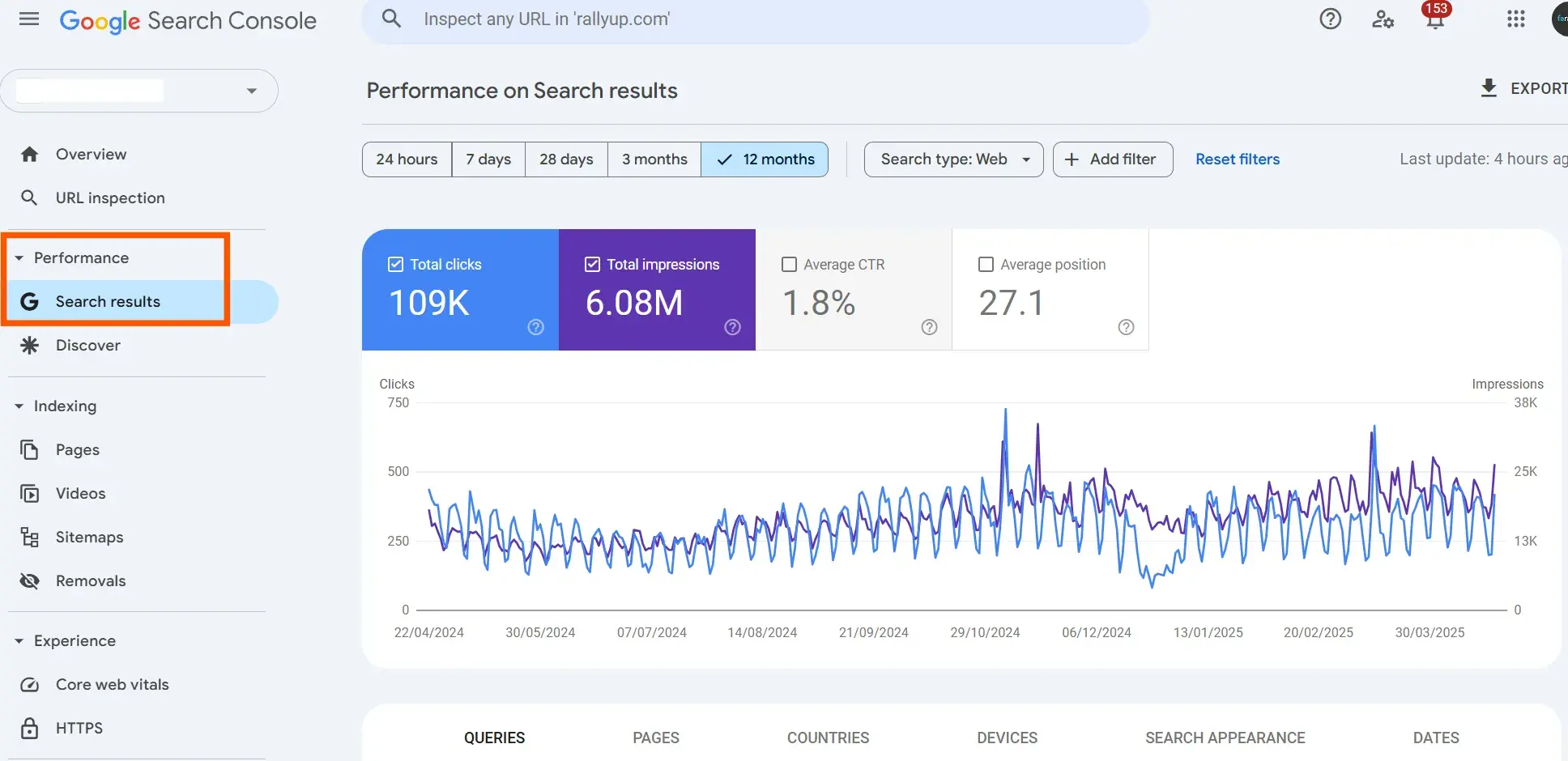
Step 2: Filter the report.
Within the performance report, you can filter the report by
- Queries
- Dates
- Pages
- Countries
- Devices
- Search appearance (review snippet, translated results, product snippet)
- Search type (web, image, video)
For this exercise, filter by pages.
If your knowledge base lives in a subfolder, such as /knowledge-base/, this becomes super easy. Just filter by pages containing that subfolder, and you’ll only see data for your knowledge base pages.
Pro tip: Want to see what questions people are asking to find your knowledge base? Try adding a regex filter to show only queries with words like “how,” “what,” “why,” or “can.” It’s a quick way to surface question-based, long-tail keywords that could inspire new content.
Here’s the filter I use:
Who|what|when|where|why|how|is|are|can|does|do|should|could|would|will|did|was|were
And here’s where to add it in GSC.
- When you’re in the Search Results report, you should see “+ Add Filter.” Click that.
- Choose “Custom (regex)” and “Matches regex” from the drop-downs.
- Paste the filter I use into the text box.
- Click apply.
Once done, the graph will change to reflect keywords containing those words, and the queries below the graph will be question queries.

Step 3: Export the data to Google Sheets.
If you prefer, you can analyze the data within the table in Google Search Console, but I prefer to export the report to Google Sheets because it allows for more detailed filtering.
I add filters to columns or use conditional formatting to highlight words or phrases.
Step 4: Analyze the data.
It’s tricky to tell you exactly what to analyze, as it will depend on your site and what people are searching, but here are some things I might look for:
- Question keywords: You can use conditional formatting and the question keywords if you didn’t filter them in the step above.
- High-impression, low-click keywords are an indicator that your ranking for a keyword could be improved.
- Knowledge base pages with zero clicks may uncover some SEO opportunities.
- Seasonal trends may reveal particular products or challenges that arise seasonally. If you are aware of seasonal trends, you can plan to address customer challenges through marketing proactively.
Use Google Analytics.
This next tip will work if you
- Have search functionality on your knowledge base.
- Search creates parameter URLs containing keywords.
Let’s walk through using GA4 to find data about topics.
Step 1: Go to G4 and explore.
On G4, you can create a free-form exploration that allows you to track URL parameters containing specific keywords, provided your SEO knowledge base is set up to include them.
Navigate to “Explore” in the left side menu and click “Free-Form.”
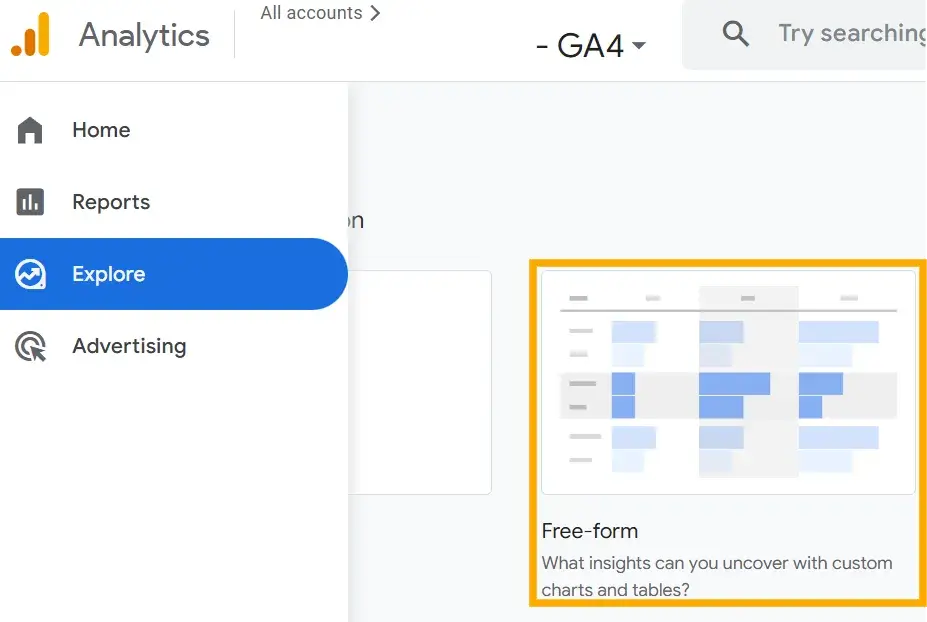
Step 2: Set up the free-form.
To set up the form, you need to add “Page path + query string” dimensions.
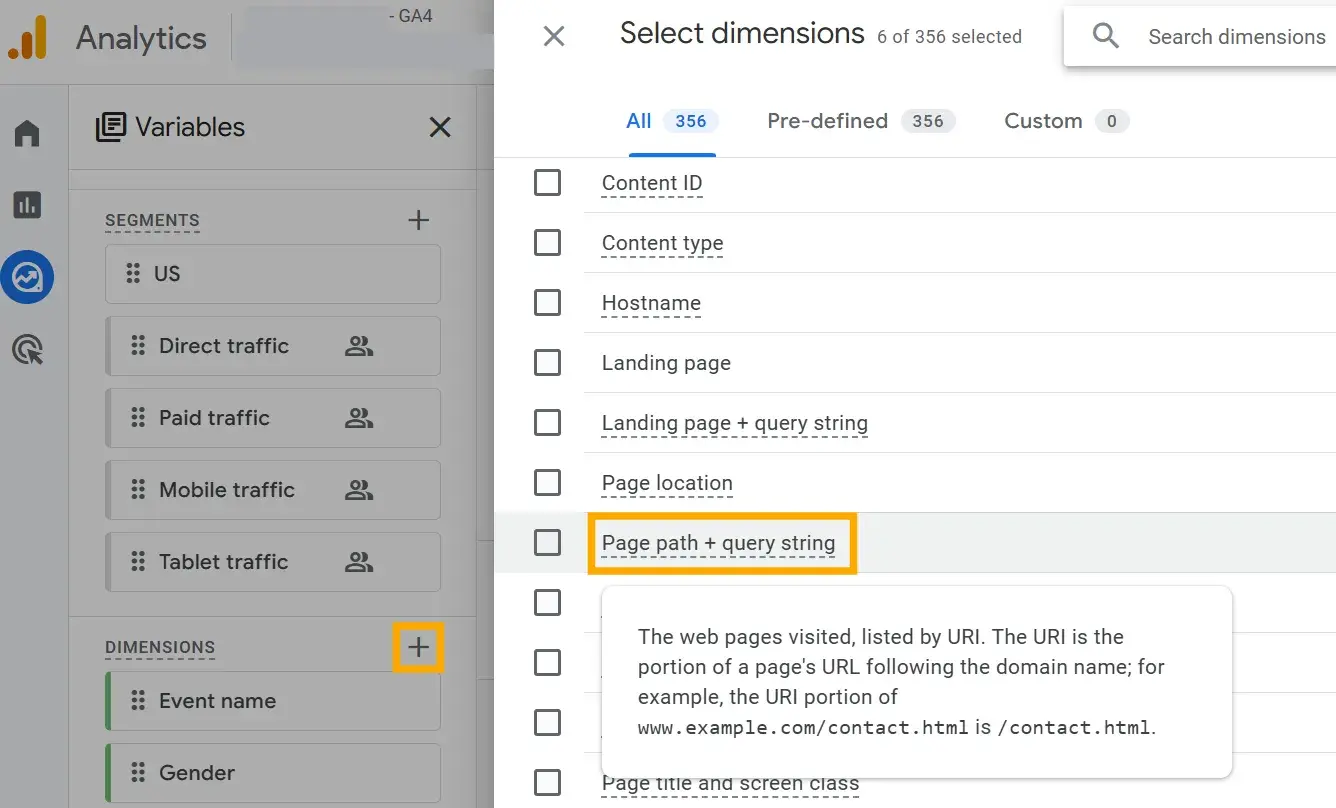
Then, you need to add the metrics that are most meaningful to you. One metric you will certainly want to add is views.
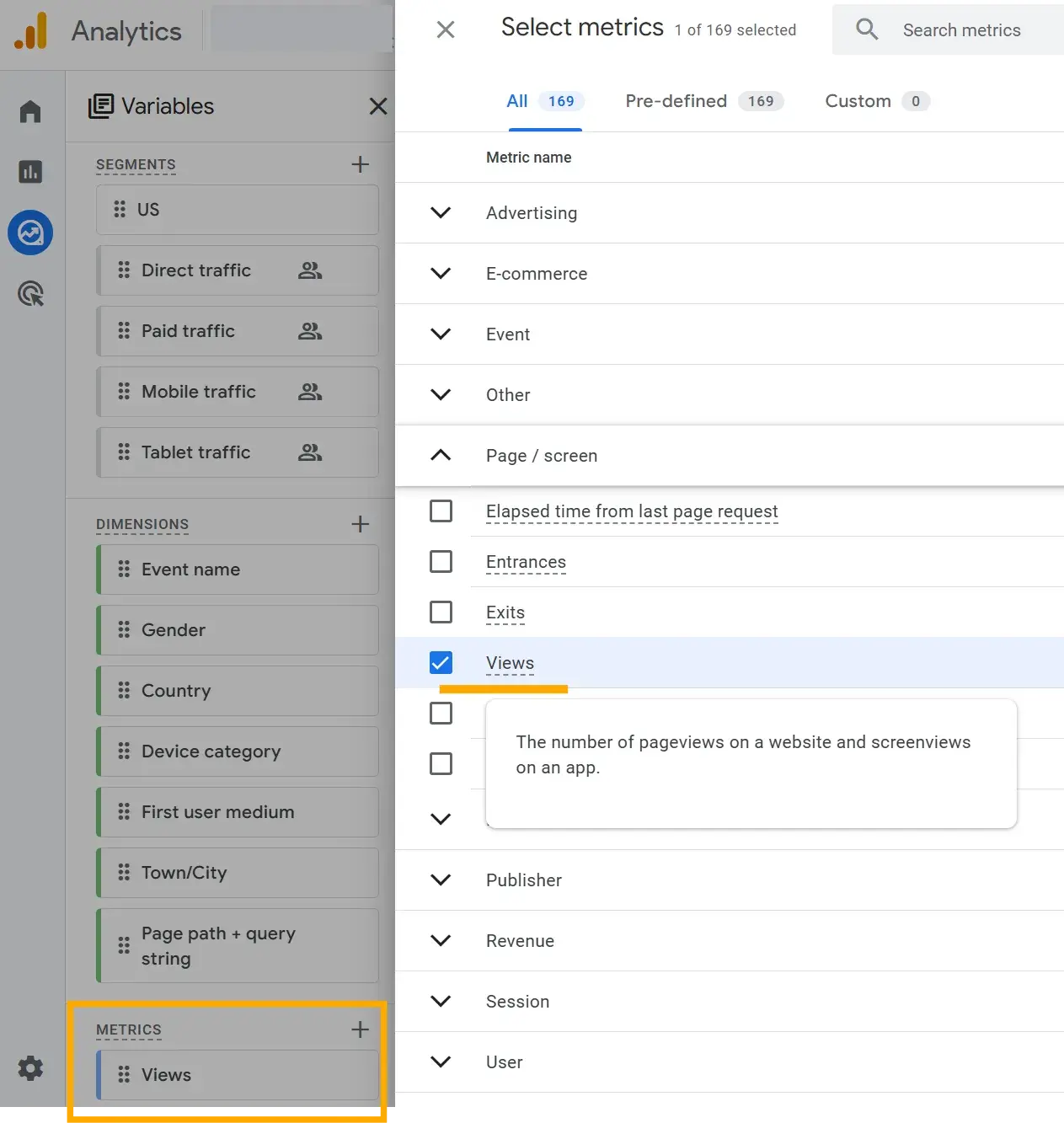
Step 3: Filter using your search URL.
To view specific URLs, filter the data to URLs containing only the search parameter.
For this demonstration, I’m using HubSpot’s parameter as an example. Let me show you what I mean.
When you go to HubSpot’s knowledge base and use the search bar, the page changes, and the URL includes a parameter. See screenshot below.

This is really helpful because every search contains the formula search.
In the screenshot below, I’ve filtered by ‘search?’ and then the keyword. You might use it if you set up your SEO knowledge base in the same way HubSpot’s knowledge base works.
If you know your URL parameter structure, you can configure your free-from exploration to see all URLs containing “search?”. Then, you can filter the URLs by the most viewed URLs to determine what people are searching for the most.
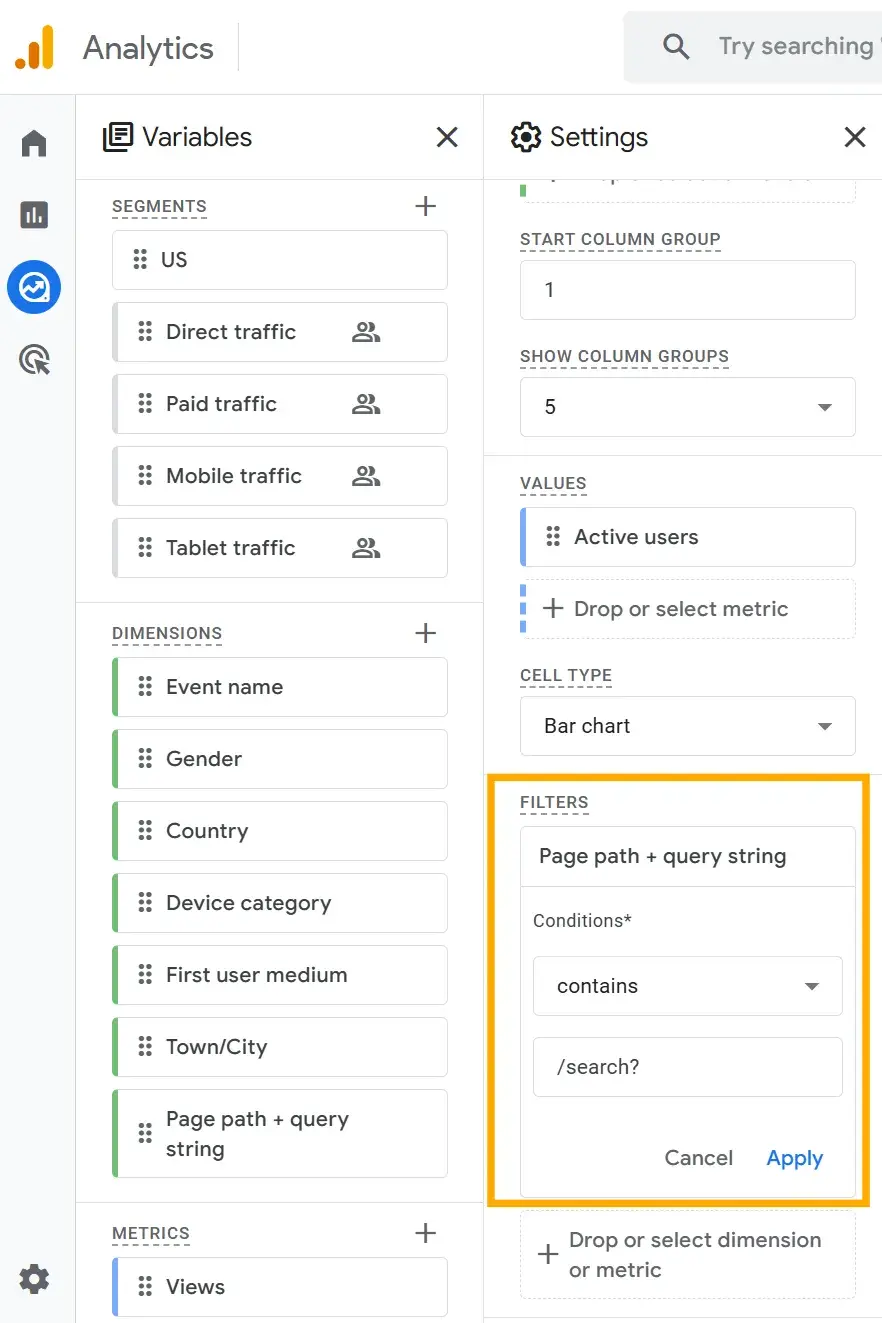
If you know what users are searching for, you can create topics within your SEO knowledge base to answer commonly asked queries or keywords.
Pro tip: HubSpot’s Knowledge Base does this, so if you’re in the early stages of building a knowledge base, check it out.
Tips for Adding SEO to Your Knowledge Base
SEO skills are very transferable to creating an SEO-friendly knowledge base. Many of the rules and tactics apply. Let’s review some of the most important ones here.
Follow good SEO practices.
Ranking your knowledge base requires traditional SEO practices such as
- Using a hierarchical heading structure.
- Any images should be accompanied by descriptive alt text.
- Write your title tags and meta description for SEO, but also to encourage a click.
- Use your keywords smartly and in key placements (covered in the next section).
- And so much more.
Let keyword research guide you.
Keyword research for your knowledge base should be largely the same as keyword research for your website.
For a knowledge base, I begin by discussing with sales and customer service to determine the types of content or queries they would like the knowledge base to cover. It is of utmost importance that your knowledge base is useful and allows users to self-serve their challenges, and therefore alleviating pressure on sales and customer service teams.
Based on internal insights, I conduct keyword research using tools like Semrush, Keywords Everywhere, or your Google Search Console (GSC).
Important note: When it comes to the knowledge base, worry less about keyword volumes and difficulty. You know that the keywords are relevant because your customers or prospects are searching for them. Sometimes, niche keywords or topics appear to have zero search volume in tools, but actually have a significant amount of search traffic. This is a major perk of an SEO knowledge base; you’ll see what people are actually searching in your GSC, and so you don’t have to rely entirely on tools that are not perfect.
Your chosen keyword for the page should be placed where natural, but some of the key places to put it include:
- The URL
- Headings, especially for H1 and H2, where natural.
- Within Alt text (and the image file name)
- Within the content, where natural.
- Title tag and meta description
Consider search intent and SERP analysis.
Although your knowledge base has a purpose (to serve users looking for information), you need to conduct some SERP analysis to make the most of your SEO knowledge base.
SERP analysis is the exercise of reviewing pages ranking on Search Engine Results Pages to identify the type of content ranking for a particular keyword.
If you know what’s ranking, you can determine
- Whether or not your knowledge base is the best place to put the content.
- What to include within the knowledge base to give it the best chance of ranking.
For example, if you identify that ranking pages include videos, then your knowledge base page will likely benefit from having a video included.
Use internal links.
Internal links are a powerhouse for SEO. Unsurprisingly, your SEO knowledge base is no different.
You should use internal links within your SEO knowledge base to:
- Link to other related pieces on the knowledge base.
- Link to related products or services across the site.
- Link to the knowledge base pieces from other pages on the site.
Keep the links relevant and useful to the user, and include keywords that are clustered to the page you’re linking to within the anchor.
Keep the content up to date.
Any good content strategy has space for edits. Keep your content up to date. There’s no rule on how often a piece of content should be updated; it should be updated as and when needed.
Add the pages to your sitemap.
Your sitemap should include every indexed page on your website. Your SEO knowledge base is no exception. Make sure it’s included in your sitemap.
An SEO Knowledge Base is Superior
For me, the benefits of indexing and optimizing a knowledge base outweigh the cons. With some careful keyword mapping, you can have a knowledge base that helps your customers, provides insights about your audience’s needs, and ranks in Google.
![]()













